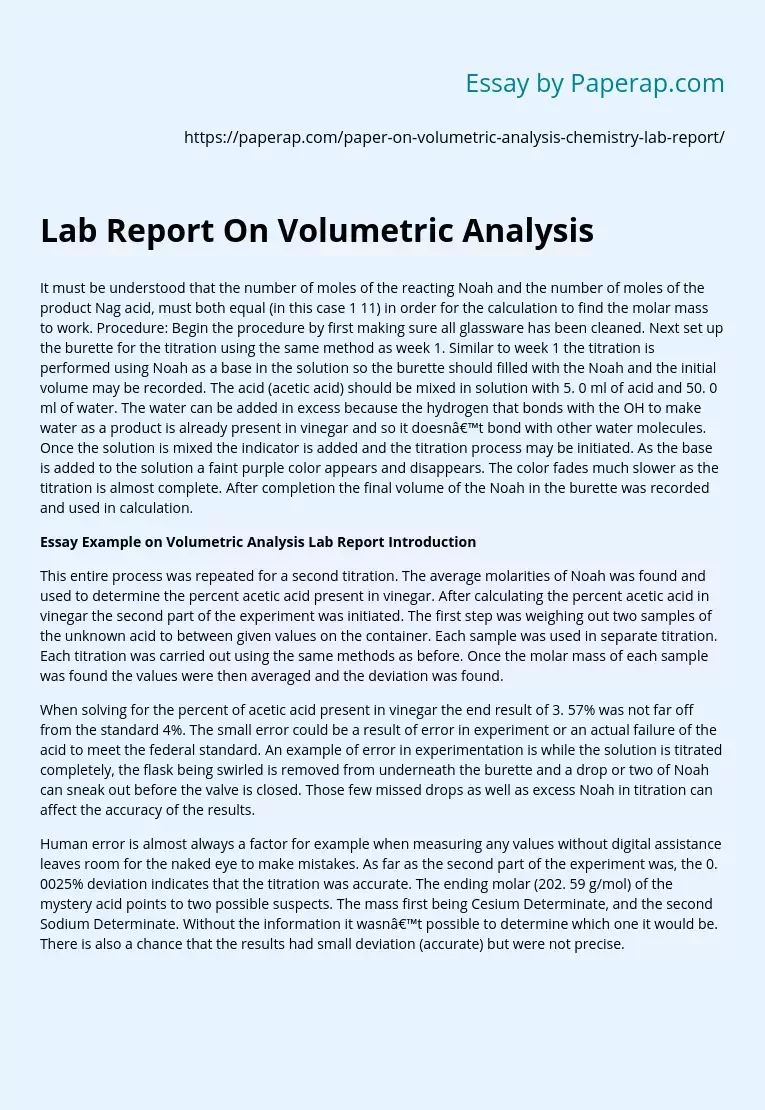It must be understood that the number of moles of the reacting Noah and the number of moles of the product Nag acid, must both equal (in this case 1 11) in order for the calculation to find the molar mass to work. Procedure: Begin the procedure by first making sure all glassware has been cleaned. Next set up the burette for the titration using the same method as week 1. Similar to week 1 the titration is performed using Noah as a base in the solution so the burette should filled with the Noah and the initial volume may be recorded.
The acid (acetic acid) should be mixed in solution with 5. 0 ml of acid and 50. 0 ml of water. The water can be added in excess because the hydrogen that bonds with the OH to make water as a product is already present in vinegar and so it doesn’t bond with other water molecules. Once the solution is mixed the indicator is added and the titration process may be initiated.
As the base is added to the solution a faint purple color appears and disappears. The color fades much slower as the titration is almost complete. After completion the final volume of the Noah in the burette was recorded and used in calculation.
Essay Example on Volumetric Analysis Lab Report Introduction
This entire process was repeated for a second titration. The average molarities of Noah was found and used to determine the percent acetic acid present in vinegar. After calculating the percent acetic acid in vinegar the second part of the experiment was initiated.
The first step was weighing out two samples of the unknown acid to between given values on the container. Each sample was used in separate titration. Each titration was carried out using the same methods as before. Once the molar mass of each sample was found the values were then averaged and the deviation was found.
When solving for the percent of acetic acid present in vinegar the end result of 3. 57% was not far off from the standard 4%. The small error could be a result of error in experiment or an actual failure of the acid to meet the federal standard. An example of error in experimentation is while the solution is titrated completely, the flask being swirled is removed from underneath the burette and a drop or two of Noah can sneak out before the valve is closed. Those few missed drops as well as excess Noah in titration can affect the accuracy of the results.
Human error is almost always a factor for example when measuring any values without digital assistance leaves room for the naked eye to make mistakes. As far as the second part of the experiment was, the 0. 0025% deviation indicates that the titration was accurate. The ending molar (202. 59 g/mol) of the mystery acid points to two possible suspects. The mass first being Cesium Determinate, and the second Sodium Determinate. Without the information it wasn’t possible to determine which one it would be. There is also a chance that the results had small deviation (accurate) but were not precise.
For example if both titration had error due to the mass of the samples being incorrect. There was also a potential error during the second titration. While adding the indicator to the acid solution the tip came in contact with the burette and the drop of indicator managed to seep up the burette into the Noah and so all the Noah that had turned purple had to be drained. Normally flushing the burette would get rid of the indicator but even after flushing the entire system there was still a faint purple lingering in the tip of the burette.
Lab Report On Volumetric Analysis. (2019, Nov 27). Retrieved from https://paperap.com/paper-on-volumetric-analysis-chemistry-lab-report/

